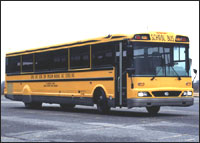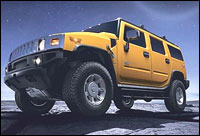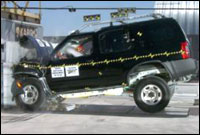
Clean up the bus, gus.
Photo: NREL.
The Bush administration has taken to singing the clean-car gospel lately, but it’s not quite hitting all the notes. Last month, U.S. EPA chief Mike Leavitt joined Detroit kingpins in a splashy D.C. conference to trumpet the arrival of new vehicles and fuels that reduce sulfur emissions — a notable achievement, but what Leavitt was passing off as a Bush administration success was in fact an initiative launched under President Clinton. Days later, Leavitt announced additional funding for the Clean School Bus USA program — some $60 million to replace pre-1991 school buses with new ones that have state-of-the-art emission controls. Environmentalists pooh-poohed the program as a small effort that will have a negligible effect on emissions, and they noted that it’s part of a larger PR blitz in election battleground states.
While these efforts drew lots of media attention, there was one recent car-related announcement that the Bush administration slipped under the radar, and this one is likely to have much broader effects. On Dec. 22, the Bush administration proposed a major rewrite of the Corporate Average Fuel Economy (CAFE) program. One notable outcome of the proposal would be the closing of a loophole that currently exempts vehicles over 8,500 pounds, such as the Hummer H2, from any fuel-efficiency standards whatsoever. But despite this welcome tidbit, few environmentalists were pleased with the proposal as a whole.
“The loophole the Bush administration proposes to close may move us one step forward,” said Daniel Becker, director of the Sierra Club’s global warming and energy program. “But their proposal also includes another loophole for the auto industry that will move us three steps back.”

Hum diddle dee.
The big concern, according to Becker, is that the Bush administration would regulate the fuel economy of light trucks by dividing them into weight or size classes instead of using fleet-wide efficiency targets. While the current CAFE program has two automotive classes — cars and light trucks — the new proposal would create additional truck weight classes, with different fuel-economy standards for each classification. In a nutshell, said Becker, the system would produce an incentive for companies to add weight to their cars to bump them up into higher classes and qualify them for looser efficiency restrictions.
Something similar happened in response to the original CAFE rules. “Those rules were written in 1975 when no one imagined that vehicles would ever have a weight over 8,500 pounds,” said Becker. But as consumer demand grew for bigger, fatter cars, automakers began exploiting that loophole by putting out models such as the Ford Excursion and the Hummer that weigh in just over the 8,500-pound limit. There’s no reason to think they won’t continue this trend of up-weighting when there are more truck weight classes, Becker argued.

PT Cruiser — a “truck” no more?
Photo: DOE.
On a positive note, the rule changes would also narrow the definition of light truck so auto manufacturers can’t utilize another surprising loophole: Under the current system, a vehicle can be classified as a truck if seats can be easily removed to create a flat bed of cargo space. DaimlerChrysler’s PT Cruiser squeaks into the light truck category for this reason, making it subject to laxer mileage regs than a car, and there are a number of other new vehicles that fall into this ambiguous realm between cars and trucks. Stuart Schorr, a spokesperson for DaimlerChrysler, called the proposed clarification of the light-truck definition “a wallop that will disadvantage companies that are focusing in [this in-between realm], and seriously crimp industry profits.”
Still, it’s not clear how much of an impact, if any, the Bush administration’s new plan would have because details have yet to be set. So far, the proposal is outlined in vague terms, without specific numbers for mileage standards in each category.
CAFE Break
Current CAFE standards require new cars in model year 2005 to average 27.5 miles per gallon and light trucks to average 21 mpg — targets that have hardly changed in the last two decades. Developed in the mid-1970s in response to the oil crisis brought on by the Arab oil embargo, CAFE standards immediately prompted a flurry of histrionic protest from Detroit. Car makers complained that they would be forced to focus their manufacturing on tiny two-passenger cars that were not only impractical but unsafe. A Ford spokesperson testified before Congress in 1974 that the proposed mileage standards would “result in a Ford product line consisting of either all sub-Pinto-sized vehicles or some mix of vehicles ranging from a sub-sub-compact to perhaps a Maverick.”
Well, we saw how that went. Now, when bloated Suburbans and Yukons are the favored modes of transport for groceries, it’s abundantly clear that car manufacturing has been going anywhere but in the direction of the Pinto. Today a whopping 50 percent of vehicles sold in the U.S. fit into the light-truck category, up from 20 percent when CAFE was implemented.
In the ’70s, CAFE also elicited gloomy predictions of a major spike in automobile-related deaths and panicked claims that Detroit’s revenues would plummet. Obviously, these things never happened — just the opposite. Since 1975, when the standards were first implemented, automobile-related death rates have fallen by more than 12 percent and Detroit’s revenues have ballooned by more than 300 percent. So much for the doomsday scenarios.
However, hopeful predictions about improved fuel efficiency fared no better. In fact, the 2003 automotive fleet had the worst average fuel economy of any fleet since the standards were set — 22.7 mpg, combining car and light-truck averages — thanks to glaring CAFE loopholes and the increasing popularity of gas-guzzling SUVs.
“Everyone agrees CAFE regulations are desperately in need of overhaul,” said Becker, “but not a way that accelerates this ludicrous trend toward heavier and heavier cars.”
The Safety Dance
For its part, the Bush administration defends the CAFE overhaul as an effort to encourage greater highway safety, citing federal research indicating that current regulations may undermine motorists’ safety by encouraging auto manufacturers to make their vehicles lighter.

No crash test dummies were harmed
in the making of this photo.
Photo: NHTSA.
But a growing mountain of evidence debunks this line of thinking. In the Jan. 12 issue of The New Yorker, a Malcolm Gladwell expose revealed that an SUV’s size and weight give it less precise and responsive handling, longer braking times, and a higher risk of rollover — all serious safety disadvantages. Gladwell also argues that drivers of large vehicles develop an attitude of invincibility that leads to recklessness.
According to Clarence Ditlow, director of the Center for Auto Safety, new reports consistently show “that heavier vehicles are far and away more deadly — these are rolling battering rams that cause more carnage not only to the car’s passengers but to those in the other cars involved in the crash.” In addition to the high risk of rollover, says Ditlow, most trucks have a steel beam that runs from bumper to bumper and makes the vehicles very rigid during a crash, whereas cars have a “crumple zone” that absorbs force so the occupants don’t feel as much of the impact.
This crumple zone was in fact one of the innovations developed by auto manufacturers to make lighter cars safer after CAFE standards were introduced — along with air bags, anti-lock braking systems, and better seatbelt designs. “The assumption that requiring car companies to develop lighter, more efficient cars is a direct public-health threat completely ignores Detroit’s power to innovate and an impressive record of technological creativity,” said Ditlow.
In addition to perpetuating the safety myth, the Bush administration has been misleading the American public with its argument that stricter CAFE standards will lead to job loss and damage the economy. On the contrary, it is Detroit’s sluggish pace in the global race to build the next generation of efficient vehicles that poses the biggest risk to the U.S. automotive industry.

Less is more: the 2004 Prius.
Even as Motor Trend has named the hybrid Toyota Prius its 2004 Car of the Year, the Big Three have stalled on their own hybrid plans. Ford intended to release its hybrid Escape SUV by the end of 2003, but is delaying the release until summer 2004. It has also scrapped its 2000 pledge to improve the fuel economy of its SUVs 25 percent by 2005. And General Motors’ hybrid Saturn VUE SUV won’t hit the roads until model year 2006.
Of American car companies, General Motors has the most to lose. GM has long been the world’s largest automaker, but its global market share is declining, and in 2003, Toyota’s net income outpaced GM’s by almost $3 billion. Toyota owes some portion of that success to the rapid growth of its hybrid sales. In 2003, Toyota sold more than 20,000 hybrid Prius models in the U.S. — only three years after introducing the car to market. That’s an impressive number, especially given that the car’s concept is still so confusing to American buyers that they often ask salespeople, “Where do you plug it in?” In 2004, Prius sales are expected to reach 47,000. Both Toyota and Honda have announced plans to have hybrid versions of every model in their inventories by 2007.
The Wheel Deal
Some industry analysts warn that by refusing to jump on the fuel-efficiency bandwagon, American automakers will perpetually be six years behind their Japanese counterparts. U.S. automakers counter that they’re just following market cues. “We’d be happy to make more efficient cars if consumers wanted to buy them. What incentivizes us more than anything is the demands of the marketplace,” said Eron Shosteck, a spokesperson for the Alliance of Automobile Manufacturers. “Our problem is that whether or not we produce fuel-efficient models to meet CAFE standards, American consumers by and large want bigger cars.”

Stuck in traffic?
Photo: ORNL.
According to Shosteck, the argument that the gas-guzzling epidemic in America is Detroit’s fault and could be solved merely by the production of more fuel-efficient cars is like saying that obesity in America is the clothing industry’s fault and could be solved if only clothing manufacturers would start offering smaller sizes.
Strained analogies aside, Shosteck is right that most consumers in America aren’t interested in buying fuel-efficient cars, largely because they have no price signals to reflect the environmental and political cost of gasoline consumption. It’s no coincidence that Japan and Europe are leading in clean-energy development and their gas prices are three to four times higher than those in the U.S.
Some insiders in Detroit are starting to make this same argument. “DaimlerChrysler has publicly supported the gas tax, because that’s the best way to change consumer behavior,” said company spokesperson Schorr. “We’ve said to Washington, ‘If you want consumers to treat fuel as a special commodity, you need to put a message directly into the marketplace.'”
But of course Washington politicians believe a new gas tax would be political suicide, which is why not a single Democratic presidential candidate proposed it as an instrument in their energy-independence toolkits. Furthermore, consumer behavior in the United States has not shown signs of changing in response to higher gas prices. Over the last four years, gas prices in the U.S. have risen 50 percent — and gas consumption has also risen, from 7 million barrels a day to 8 million.
Ultimately, American consumers might be persuaded by incentives — strong federal tax breaks for clean vehicles, for instance, and increasingly popular state-level laws that allow owners of hybrid vehicles to drive in carpool lanes during peak commuting times.
What Americans clearly don’t want to do is sacrifice style for substance — and like it or not, the style of choice these days is the SUV. Perhaps the silver-bullet argument that’ll persuade American consumers to buy fuel-efficient cars will come in the form of the hybrid Ford Escape SUV, set to hit showrooms this summer. Or it could be the forthcoming hybrid Toyota Highlander SUV, or the Lexus RX SUV, which the company is pledging will have all the power of a V-8 model with the fuel-efficiency of a Corolla sedan. These hybrids might just change minds as they turn heads.


